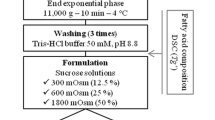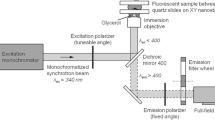Abstract
This work aimed at characterizing the biochemical and biophysical properties of the membrane of Lactococcus lactis TOMSC161 cells during fermentation at different temperatures, in relation to their freeze-drying and storage resistance. Cells were cultivated at two different temperatures (22 and 30 °C) and were harvested at different growth phases (from the middle exponential phase to the late stationary phase). Bacterial membranes were characterized by determining the fatty acid composition, the lipid phase transition, and the membrane fluidity. Cultivability and acidification activity losses of L. lactis were quantified after freezing, drying, and 3 months of storage. The direct measurement of membrane fluidity by fluorescence anisotropy was linked to lipid composition, and it was established that the cyclopropanation of unsaturated fatty acids with concomitant membrane rigidification during growth led to an increase in the freeze-drying and storage resistance of L. lactis. As expected, cultivating cells at a lower fermentation temperature than the optimum growth temperature induced a homeoviscous adaptation that was demonstrated by a lowered lipid phase transition temperature but that was not related to any improvement in freeze-drying resistance. L. lactis TOMSC161 was therefore able to develop a combined biochemical and biophysical response at the membrane level during fermentation. The ratio of cyclic fatty acids to unsaturated fatty acids (CFA/UFA) appeared to be the most relevant parameter associated with membrane rigidification and cell resistance to freeze-drying and storage. This study increased our knowledge about the physiological mechanisms that explain the resistance of lactic acid bacteria (LAB) to freeze-drying and storage stresses and demonstrated the relevance of complementary methods of membrane characterization.




Similar content being viewed by others
References
Beney L, Gervais P (2001) Influence of the fluidity of the membrane on the response of microorganisms to environmental stresses. Appl Microbiol Biotechnol 57(1–2):34–42
Beranova J, Jemiola-Rzeminska M, Elhottova D, Strzalka K, Konopasek I (2008) Metabolic control of the membrane fluidity in Bacillus subtilis during cold adaptation. BBA-Biomembranes 1778(2):445–453. doi:10.1016/j.bbamem.2007.11.012
Bischof JC, Wolkers WF, Tsvetkova NM, Oliver AE, Crowe JH (2002) Lipid and protein changes due to freezing in dunning AT-1 cells. Cryobiology 45(1):22–32
Broadbent JR, Lin C (1999) Effect of heat shock or cold shock treatment on the resistance of Lactococcus lactis to freezing and lyophilization. Cryobiology 39(1):88–102. doi:10.1006/cryo.1999.2190
Castro HP, Teixeira PM, Kirby R (1995) Storage of lyophilized cultures of Lactobacillus bulgaricus under different relative humidities and atmospheres. Appl Microbiol Biotechnol 44(1–2):172–176
Chu-Ky S, Tourdot-Marechal R, Marechal P-A, Guzzo J (2005) Combined cold, acid, ethanol shocks in Oenococcus oeni: effects on membrane fluidity and cell viability. Biochim Biophys Acta 1717(2):118–24. doi:10.1016/j.bbamem.2005.09.015
Coulibaly I, Dubois-Dauphin R, Destain J, Fauconnier M-L, Lognay G, Thonart P (2010) The resistance to freeze-drying and to storage was determined as the cellular ability to recover its survival rate and acidification activity. Int J Microbiol 2010:625239. doi:10.1155/2010/625239
Coulibaly I, Dubois-Dauphin R, Danthine S, Majad L, Mejoub T, Destain J, Bera F, Wathelet JP, Thonart P (2011) Preservation of industrial’s lactic acid bacteria (probiotics) by freeze-drying. Biotechnol Agron Soc 15(2):287–299
Crowe JH, McKersie BD, Crowe LM (1989a) Effects of free fatty acids and transition temperature on the stability of dry liposomes. Biochim Biophys Acta 979(1):7–10. doi:10.1016/0005-2736(89)90516-6
Crowe JH, Hoekstra FA, Crowe LM, Anchordoguy TJ, Drobnis E (1989b) Lipid phase transitions measured in intact cells with Fourier transform infrared spectroscopy. Cryobiology 26(1):76–84
Da Silveira MG, Golovina EA, Hoekstra FA, Rombouts FM, Abee T (2003) Membrane fluidity adjustments in ethanol-stressed Oenococcus oeni cells. Appl Environ Microbiol 69(10):5826–5832. doi:10.1128/aem. 69.10.5826-5832.2003
Daly C, Fitzgerald GF, O’Connor L, Davis R (1998) Technological and health benefits of dairy starter cultures. Int Dairy J 8(3):195–205. doi:10.1016/s0958-6946(98)00042-9
Drici-Cachon Z, Cavin JF, Divies C (1996) Effect of pH and age of culture on cellular fatty acid composition of Leuconostoc oenos. Lett Appl Microbiol 22(5):331–334. doi:10.1111/j.1472-765X.1996.tb01172.x
Fonseca F, Beal C, Corrieu G (2000) Method of quantifying the loss of acidification activity of lactic acid starters during freezing and frozen storage. J Dairy Res 67(1):83–90
Fox MH, Delohery TM (1987) Membrane fluidity measured by fluorescence polarization using an EPICS V cell sorter. Cytometry 8(1):20–25
Franks F (1998) Freeze-drying of bioproducts: putting principles into practice. Eur J Pharm Biopharm 45:221–229
Gautier J, Passot S, Penicaud C, Guillemin H, Cenard S, Lieben P, Fonseca F (2013) A low membrane lipid phase transition temperature is associated with a high cryotolerance of Lactobacillus delbrueckii subspecies bulgaricus CFL1. J Dairy Sci 96(9):5591–5602
Grogan DW, Cronan JE (1997) Cyclopropane ring formation in membrane lipids of bacteria. Microbiol Mol Biol Rev 61(4):429–441
Guillot A, Obis D, Mistou MY (2000) Fatty acid membrane composition and activation of glycine-betaine transport in Lactococcus lactis subjected to osmotic stress. Int J Food Microbiol 55(1–3):47–51. doi:10.1016/s0168-1605(00)00193-8
Hartig C, Loffhagen N, Harms H (2005) Formation of trans fatty acids is not involved in growth-linked membrane adaptation of Pseudomonas putida. Appl Environ Microbiol 71(4):1915–1922. doi:10.1128/aem. 71.4.1915-1922.2005
Hua L, Zhao WY, Wang H, Li ZC, Wang AL (2009) Influence of culture pH on freeze-drying viability of Oenococcus oeni and its relationship with fatty acid composition. Food Bioprod Process 87(C1):56–61. doi:10.1016/j.fbp.2008.06.001
Johnsson T, Nikkila P, Toivonen L, Rosenqvist H, Laakso S (1995) Cellular fatty acid profiles of Lactobacillus and Lactococcus strains in relation to the oleic acid content of the cultivation medium. Appl Environ Microbiol 61(12):4497–4499
Jouppila K, Kansikas J, Roos YH (1997) Glass transition, water plasticization, and lactose crystallization in skim milk powder. J Dairy Sci 80(12):3152–3160
Keweloh H, Heipieper HJ (1996) Trans unsaturated fatty acids in bacteria. Lipids 31(2):129–137. doi:10.1007/bf02522611
Kurtmann L, Carlsen CU, Risbo J, Skibsted LH (2009a) Storage stability of freeze-dried Lactobacillus acidophilus (La-5) in relation to water activity and presence of oxygen and ascorbate. Cryobiology 58(2):175–180. doi:10.1016/j.cryobiol.2008.12.001
Kurtmann L, Skibsted LH, Carlsen CU (2009b) Browning of freeze-dried probiotic bacteria cultures in relation to loss of viability during storage. J Agric Food Chem 57(15):6736–6741. doi:10.1021/jf901044u
Leroy F, de Vuyst L (2004) Lactic acid bacteria as functional starter cultures for the food fermentation industry. Trends Food Sci Tech 15(2):67–78
Li C, Zhao JL, Wang YT, Han X, Liu N (2009) Synthesis of cyclopropane fatty acid and its effect on freeze-drying survival of Lactobacillus bulgaricus L2 at different growth conditions. World J Microbiol Biotechnol 25(9):1659–1665. doi:10.1007/s11274-009-0060-0
Linders LJM, Wolkers WF, Hoekstra FA, VantRiet K (1997) Effect of added carbohydrates on membrane phase behavior and survival of dried Lactobacillus plantarum. Cryobiology 35(1):31–40. doi:10.1006/cryo.1997.2021
Loffhagen N, Hartig C, Geyer W, Voyevoda M, Harms H (2007) Competition between cis, trans and cyclopropane fatty acid formation and its impact on membrane fluidity. Eng Life Sci 7(1):67–74. doi:10.1002/elsc.200620168
Mazur P (1977) Role of intracellular freezing in death of cells cooled at supraoptimal rates. Cryobiology 14(3):251–272
Munoz-Rojas J, Bernal P, Duque E, Godoy P, Segura A, Ramos JL (2006) Involvement of cyclopropane fatty acids in the response of Pseudomonas putida KT2440 to freeze-drying. Appl Environ Microbiol 72(1):472–477. doi:10.1128/aem. 72.1.472-477.2006
Oldenhof H, Wolkers WF, Fonseca F, Passot SP, Marin M (2005) Effect of sucrose and maltodextrin on the physical properties and survival of air-dried Lactobacillus bulgaricus: an in situ Fourier transform infrared spectroscopy study. Biotechnol Prog 21(3):885–892. doi:10.1021/bp049559j
Rozes N, Garbay S, Denayrolles M, Lonvaudfunel A (1993) A rapid method for the determination of bacterial fatty-acid composition. Lett Appl Microbiol 17(3):126–131
Ruckold S, Grobecker KH, Isengard HD (2001) The effects of drying on biological matrices and the consequences for reference materials. Food Control 12(7):401–407
Schleifer KH, Kraus J, Dvorak C, Kilpperbalz R, Collins MD, Fischer W (1985) Transfer of Streptococcus lactis and related streptococci to the genus Lactococcus gen. nov. Syst Appl Microbiol 6(2):183–195
Schoug A, Fischer J, Heipieper HJ, Schnuerer J, Hakansson S (2008) Impact of fermentation pH and temperature on freeze-drying survival and membrane lipid composition of Lactobacillus coryniformis Si3. J Ind Microbiol Biotechnol 35(3):175–181. doi:10.1007/s10295-007-0281-x
Schwab C, Vogel R, Ganzle MG (2007) Influence of oligosaccharides on the viability and membrane properties of Lactobacillus reuteri TMW1.106 during freeze-drying. Cryobiology 55(2):108–114. doi:10.1016/j.cryobiol.2007.06.004
Sinensky M (1974) Homeoviscous adaptation - a homeostatic process that regulates the viscosity of membrane lipids in Escherichia coli. Proc Natl Acad Sci U S A 71(2):522–5. doi:10.1073/pnas.71.2.522
Smittle RB, Gilliland SE, Speck ML, Walter WM Jr (1974) Relationship of cellular fatty acid composition to survival of Lactobacillus bulgaricus in liquid nitrogen. Appl Microbiol 27(4):738–43
Spinnler HE, Corrieu G (1989) Automatic method to quantify starter activity based on pH measurement. J Dairy Res 56(5):755–764
Streit F, Corrieu G, Beal C (2007) Acidification improves cryotolerance of Lactobacillus delbrueckii subsp. bulgaricus CFL1. J Biotechnol 128(3):659–667. doi:10.1016/j.jbiotec.2006.11.012
Teixeira H, Goncalves MG, Rozes N, Ramos A, San Romao MV (2002) Lactobacillic acid accumulation in the plasma membrane of Oenococcus oeni: a response to ethanol stress? Microb Ecol 43(1):146–153. doi:10.1007/s00248-001-0036-6
Teixeira P, Castro H, Kirby R (1996) Evidence of membrane lipid oxidation of spray-dried Lactobacillus bulgaricus during storage. Lett Appl Microbiol 22(1):34–38
Thi Mai Huong T, Grandvalet C, Tourdot-Marechal R (2011) Cyclopropanation of membrane unsaturated fatty acids is not essential to the acid stress response of Lactococcus lactis subsp. cremoris. Appl Environ Microbiol 77(10):3327–3334. doi:10.1128/aem. 02518-10
Tymczyszyn EE, Gomez-Zavaglia A, Disalvo EA (2005) Influence of the growth at high osmolality on the lipid composition, water permeability and osmotic response of Lactobacillus bulgaricus. Arch Biochem Biophys 443(1–2):66–73
Velly H, Fonseca F, Passot S, Delacroix-Buchet A, Bouix M (2014) Cell growth and resistance of Lactococcus lactis subsp. lactis TOMSC161 following freezing, drying and freeze-dried storage are differentially affected by fermentation conditions. J Appl Microbiol 117(3):729–40
Wang Y, Delettre M, Guillot A, Corrieu G, Beal C (2005) Influence of cooling temperature and duration on cold adaptation of Lactobacillus acidophilus RD758. Cryobiology 50(3):294–307. doi:10.1016/j.cryobiol.2005.03.001
Wu CD, Zhang J, Wang M, Du GC, Chen J (2012) Lactobacillus casei combats acid stress by maintaining cell membrane functionality. J Ind Microbiol Biotechnol 39(7):1031–1039. doi:10.1007/s10295-012-1104-2
Zhang Y-M, Rock CO (2008) Membrane lipid homeostasis in bacteria. Nat Rev Microbiol 6(3):222–233. doi:10.1038/nrmicro1839
Zhao WY, Li H, Wang H, Li ZC, Wang AL (2009) The effect of acid stress treatment on viability and membrane fatty acid composition of Oenococcus oeni SD-2a. Agric Sci China 8(3):311–316. doi:10.1016/s1671-2927(08)60214-x
Acknowledgments
This work was supported by the Centre National Interprofessionnel de l’Economie Laitière (Paris, France). The authors thank Savoîcime for providing the reference strain.
Author information
Authors and Affiliations
Corresponding author
Rights and permissions
About this article
Cite this article
Velly, H., Bouix, M., Passot, S. et al. Cyclopropanation of unsaturated fatty acids and membrane rigidification improve the freeze-drying resistance of Lactococcus lactis subsp. lactis TOMSC161. Appl Microbiol Biotechnol 99, 907–918 (2015). https://doi.org/10.1007/s00253-014-6152-2
Received:
Accepted:
Published:
Issue Date:
DOI: https://doi.org/10.1007/s00253-014-6152-2




